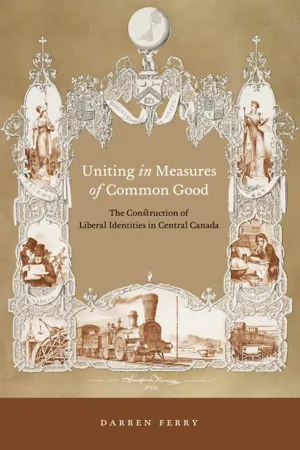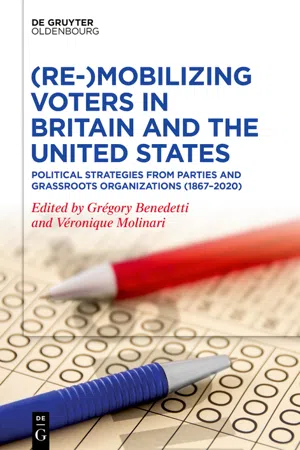History
Granger Movement
The Granger Movement was a political and social movement that emerged in the United States during the late 19th century. It was primarily focused on advocating for the rights of farmers and rural communities, and sought to address issues such as monopolistic practices by railroads and grain elevators. The movement was named after the National Grange of the Order of Patrons of Husbandry, a fraternal organization that played a key role in its formation.
Written by Perlego with AI-assistance
Related key terms
Related key terms
1 of 4
Related key terms
1 of 3
6 Key excerpts on "Granger Movement"
- eBook - ePub
In Essentials, Unity
An Economic History of the Grange Movement
- Jenny Bourne(Author)
- 2017(Publication Date)
- Ohio University Press(Publisher)
But writing off the Patrons of Husbandry as a flash in the pan would be a mistake. They created a template for all subsequent American agricultural organizations and supplied inspiration for other types of groups as well. They provide a key historical example of how cooperative economic endeavors can succeed—and why they fail. The Grange also occupies a vital position in American legal history, because legislation associated with it raised critical issues about the role of the state in regulating private industry as well as the interactions of legislatures and courts. And the minutes from the Minnehaha subordinate allow us to peer into the workings of a long-lived American voluntary communal association to understand better how it served the economic, social, educational, and cultural needs of its members throughout the century of its existence.Perhaps most important, the Grangers as a group constituted one of the first and strongest voices questioning the hazards of extreme wealth inequality for a society. Although they may enjoy more credit than is due for the “Granger laws” that instituted railroad regulation in this country, many Grangers were certainly on the side of those who fought for such laws. The questions raised there about the nature and governance of public goods remain salient. I suspect the founders of the Grange would be pleased to know this, for they enshrined in their Declaration of Purposes - eBook - ePub
The Agrarian Crusade
A Chronicle of the Farmer in Politics
- Solon J. (Solon Justus) Buck(Author)
- 2001(Publication Date)
- Perlego(Publisher)
These court decisions established principles which even now are of vital concern to business and politics. From that time to this no one has denied the right of States to fix maximum charges for any business which is public in its nature or which has been clothed with a public interest; nor has the inclusion of the railroad and warehouse businesses in that class been questioned. The opinion, however, that this right of the States is unlimited, and therefore not subject to judicial review, has been practically reversed. In 1890 the Supreme Court declared a Minnesota law invalid because it denied a judicial hearing as to the reasonableness of rates; ¹ and the courts now assume it to be their right and duty to determine whether or not rates fixed by legislation are so low as to amount to a deprivation of property without due process of law. In spite of this later limitation upon the power of the States, the Granger decisions have furnished the legal basis for state regulation of railroads down to the present day. They are the most significant achievements of the anti-monopoly movement of the seventies.¹ 134 United States Reports, 418.CHAPTER V.
The Collapse of the Granger MovementThe first phase of the agrarian crusade, which centered around and took its distinctive name from the Grange, reached its highwater mark in 1874. Early in the next year the tide began to ebb. The number of Granges decreased rapidly during the remainder of the decade, and of over twenty thousand in 1874 only about four thousand were alive in 1880.Several causes contributed to this sudden decline. Any organization which grows so rapidly is prone to decay with equal rapidity; the slower growths are better rooted and are more likely to reach fruition. So with the Grange. Many farmers had joined the order, attracted by its novelty and vogue; others joined the organization in the hope that it would prove a panacea for all the ills that agriculture is heir to and then left it in disgust when they found its success neither immediate nor universal. Its methods of organization, too, while admirably adapted to arousing enthusiasm and to securing new chapters quickly, did not make for stability and permanence. The Grange deputy, as the organizer was termed, did not do enough of what the salesman calls "follow-up work." He went into a town, persuaded an influential farmer to go about with him in a house-to-house canvass, talked to the other farmers of the vicinity, stirred them up to interest and excitement, organized a Grange, and then left the town. If he happened to choose the right material, the chapter became an active and flourishing organization; if he did not choose wisely, it might drag along in a perfunctory existence or even lapse entirely. Then, too, the deputy's ignorance of local conditions sometimes led him to open the door to the farmers' enemies. There can be little doubt that insidious harm was worked through the admission into the Grange of men who were farmers only incidentally and whose "interest in agriculture" was limited to making profits from the farmer rather than from the farm. As D. Wyatt Aiken, deputy for the Grange in the Southern States and later member of the executive committee of the National Grange, shrewdly commented, "Everybody wanted to join the Grange then; lawyers, to get clients; doctors, to get customers; Shylocks, to get their pound of flesh; and sharpers, to catch the babes in the woods." - A. Eugene Havens, Gregory Hooks, Patrick H Mooney, Max Pfeffer(Authors)
- 2019(Publication Date)
- Routledge(Publisher)
The Granger Movement: The Grange was organized as a secret, rural fraternity, primarily concerned with the social and educational concerns of farmers. Men, women, boys, and girls (age 14 and over) were admitted on an equal basis (Tontz, 1964). Initially the Grange was a top-down organization, with no grass roots locals and little grass roots control. Grange founder, Oliver H. Kelley, had been an employee of the USDA for a short time, and although he was a Minnesota farmer by profession, he was working for the U.S. Post Office Department at the time he organized the Grange. The organization was launched in Washington with six members, all of them from Washington and some of them USDA employees (Taylor, 1953:118). They developed an elaborate ritual for a secret organization, initially opposed to organizing around political issues or economic action. Concomitant with worsening economic conditions and the growing concentration of power in the monopolies, the Grange began to address political and economic interests. In 1873 the Grange split into two factions: the Minnesota faction was anti-monopoly and concentrated on attacking railroads and other monopolies; the Iowa faction urged farmers to emulate rather than attack the business system (Saloutos and Hicks, 1951). It was the anti-monopoly faction, however, that harnessed the grievances of farmers, and in the mid-1870s the membership increased dramatically as the Grange began to focus on issues related to the railroad transportation problems: unfair freight rates and policies; scandals involving railroad financiers and speculators; free passes to political candidates and representatives. The Grange also pursued cooperative business ventures, including cooperative buying and selling warehouses, cooperative stores, and cooperative industries for manufacturing farm equipment. Politically, the Grange organized a lobby in Washington, demanded the popular election of U.S. Senators, and advocated anti-trust legislation. The Grange rise to power took place during years of severe depression and high unemployment While farmers organized to fight the railroads, industrial workers in the textiles, mines, and railroads held long and bitter strikes which were crushed by federal troops (Foner, 1975). Both farmers and workers were learning that their interests could not be protected as long as the state was controlled by or served the interests of capital. The Grange provided the major leadership for independent political action during the 1970s (Foner, 1975), and, by some accounts, industrialists feared farmers more than the workers (Boyer and Morais, 1965). The Grange united with the Knights of Labor to help form the Greenback Party in 1875, which joined with the short-lived United Labor Party in 1877 to become the National Greenback-Labor Party. As the Grange turned its energies to party politics, the class membership of the farmers’ movement was diluted to include politicians, professionals, and even businessmen whose interests were sometimes opposed to those of farmers. Differences between farmers and workers, and accusations of “communism” in the press contributed to the decline of the Grange (Buck, 1969). The Grange dropped from a membership of 858,050 in 1875, to 124,420 in 1880 (Taylor, 1953:137).Despite its short-lived heyday, the Grange and other smaller organizations managed to get legislatures in several states to pass laws regulating railroad fares, freight rates, and warehouses. The most effective laws were passed in Illinois, although Minnesota, Iowa, Wisconsin, and Missouri passed similar, but less effective laws (Benedict, 1953:101). The important national legislation came in the next decade, with the passage of the Interstate Commerce Act of 1887 which gave the federal government the power to regulate interstate traffic. Other issues raised by the Grange were implemented in the 1880s, including rural free mail delivery and the Hatch Act of 1887 which initiated state agricultural experiment stations. When the Grange began to revive after the turn of the century, following twenty-five years of decline, it began to again serve primarily as a social and educational organization, pursuing a politics of inclusion when it pursued any politics at all. The more transformative issues of ballot reform, womens suffrage, protection of the environment, and opposition to monopolies were taken up by new farm organizations, most notably the various permutations of the Farmers’ Alliance.- eBook - ePub
Uniting in Measures of Common Good
The Construction of Liberal Identities in Central Canada
- Darren Ferry(Author)
- 2008(Publication Date)
- McGill-Queen's University Press(Publisher)
And yet farmers who promoted commercial agriculture and the preservation of market forces could discover in the Grange a popular version of classic collective liberalism, which admired the ethos of honest industry and adhered strongly to the philosophy of the producer alliance. The glorification of the hardworking and independent farmer illustrates the Grange’s participation in an ideology that not only fostered social cohesion but also buttressed the rural hegemonic social order. The early Dominion Grange did in fact appreciate the importance of individual diligence, honest industry, and self-reliance, as evidenced by their motto, “Put your shoulder to the wheel; fortune helps those who help themselves.” The vast majority of Granger songs, such as “God Speed the Plow,” “Work,” and “Sowing and Reaping,” underscored the significance of honest labour for the husbandman, as a liberal harvest would only be secured through toil and exertion. As the song “Dignity of Labor” chorused:Tis toil that over nature gives man his proud control;And purifies and hallows the temple of his soul.It startles foul diseases with all their ghastly train;Puts iron in the muscle and crystal in the brain.The Grand Almighty Builder, who fashioned out the earth,Hath stamped his seal of honor on labor from her birth.32While some conclude that the majority of farmers within the Grange favoured economic protection, many of its publications were either ambivalent about or fully supportive of freer trade. As with most agrarian associations, the Patrons of Husbandry were far more concerned with ensuring equality of opportunity within the community when it came to trade practices, than with advocating a particular economic position. To the editors of the Granger , the question of tariffs was all about equal rights for farmers, and thus they demanded protection for agricultural products or unrestricted free trade. A subtle defence of free trade was then offered in the Granger : “All any government can do for the farmer, as a class, is to merely let them alone, and to give no undue advantage to other classes ... not that we believe that any such assumed advantages by protection or taxation can, in the end, benefit any class of the community, as has been pretty conclusively shown by the experience of the late depression.” The Canadian Granger echoed this position by claiming that protection, or any “trade or commerce that prevents the continuance of the demand for labour,” injured every class in the community, from the workers and the farmers to the commercial sector.33 - eBook - ePub
(Re-)Mobilizing Voters in Britain and the United States
Political Strategies from Parties and Grassroots Organisations (1867–2020)
- Gregory Benedetti, Veronique Molinari, Grégory Benedetti, Véronique Molinari(Authors)
- 2021(Publication Date)
- De Gruyter Oldenbourg(Publisher)
5 This paper thus contributes to a better understanding of the successes and limits of agrarian mobilisation.Context of Grievances and Resource Mobilisation
The sociology of social movements provides a useful framework for understanding the strategies pursued by Farmers’ Alliances to mobilise “the labouring class.”6 The farm crisis that hit the country in the late nineteenth century generated a context of grievances for the agrarian periphery. Farmers in the South and the Midwest suffered from droughts, bad crops, low prices, deflation, debt and unfair railroad rates. Farmers exported their cash crops, but monopolistic railroads had the power to fix rates and essentially controlled farmers’ access to global markets: it was often cheaper to transport grain from Chicago to Liverpool than getting it across two states.7 Traditional parties were unresponsive and left them only one option: to mobilise. Mobilising means transforming passive individuals into an active group in the pursuit of common goals, here rescuing the distressed agrarian world dependent on farmers’ well-being through cooperatives, government regulation and inflationary monetary policy. However, this transformation did not emerge out of nothing: it built upon decades of grassroots organising efforts by the Greenback-Labor Party, which focused on antimonopoly and currency reform, the Knights of Labor, a labour federation, and the Grange, an agrarian fraternal organisation and advocacy group. These institutions had been declining: Farmers’ Alliances seized the opportunity and took up the torch of reform and even radicalised their antimonopoly demands.8 - eBook - ePub
- Immanuel Ness(Author)
- 2015(Publication Date)
- Routledge(Publisher)
Historians of the movement have debated the extent to which the farmers' movement challenged the existing status quo. Some hold that the movement had a backward looking approach to reform by emphasizing the Jeffersonian myth of the small, independent, landowning farmer. Nevertheless, the demands for government regulation of railroads, monopolies, and the subtreasury plan represented a radical alternative to the capitalist industrial economy. At least several historians argue that moral reforms were equally important as the economic and political objectives of the farmers. Among those concerns expressed in the Alliance newspapers and demands issued at state and national meetings were the regulation of the sale of alcohol, the need for renewal of piety, prohibition of Sunday labor, and control of pornographic material.Economic Depression and Rural Crisis
Whether radical or conservative, in the final analysis, the self-help economics programs failed to improve the permanent condition of farmers, even though Alliance efforts were more sweeping than those of the Grange. The rate of tenancy, indebtedness, and insolvency jumped in the late 1880s and early 1890s, in part as a result of the economic depression that swept the country in the early 1890s. On the other hand, benefits from the political reforms called for by the Alliance resulted in more far-reaching changes for farmers and American citizens. Alliance and Populist political demands included the regulation of railroads, the regulation or destruction of monopolies and trusts, the institution of more democratic election laws, and various social reforms, most of which were implemented under the Progressives.Conclusion
Perhaps the enduring lesson that farmers learned from the Alliance was that a mix of self-help, lobbying, and political pressure on the two major parties worked best in the long run. The third-party venture that killed both the Farmers' Alliance and Populist Party proved a dead end.
Index pages curate the most relevant extracts from our library of academic textbooks. They’ve been created using an in-house natural language model (NLM), each adding context and meaning to key research topics.
Explore more topic indexes
Explore more topic indexes
1 of 6
Explore more topic indexes
1 of 4





